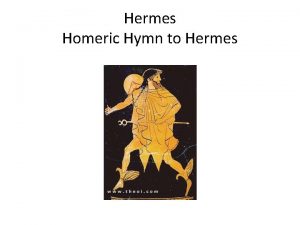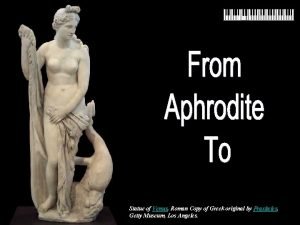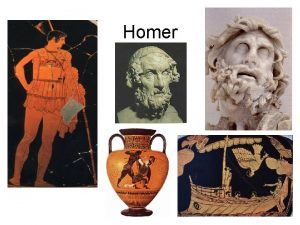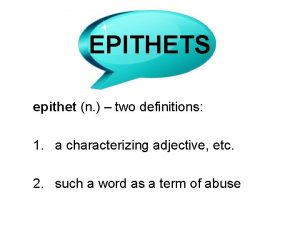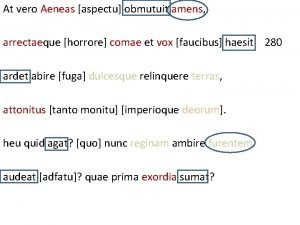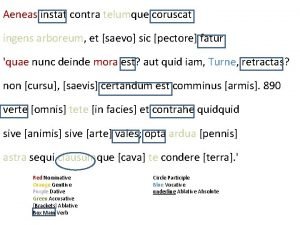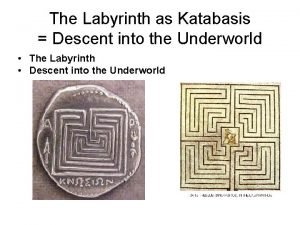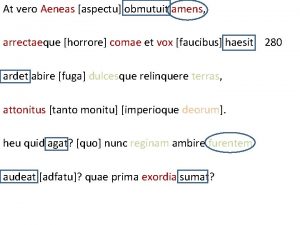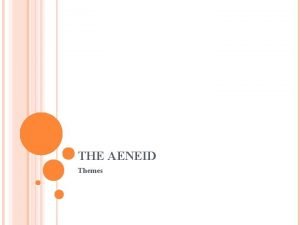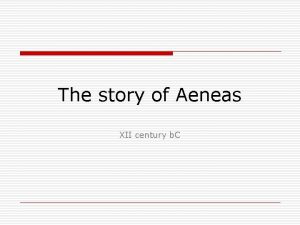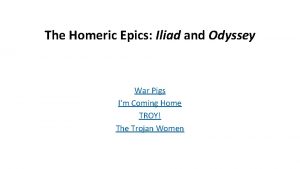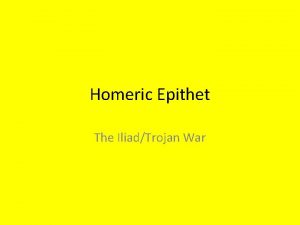Aeneas in the Homeric Story Aeneas was the






![Homer, Iliad 20. 176 ff : "Aineias [addresses Akhilleus in battle]: ‘. . . Homer, Iliad 20. 176 ff : "Aineias [addresses Akhilleus in battle]: ‘. . .](https://slidetodoc.com/presentation_image_h/152cf3f51ab391a34795e3fb0350b27e/image-7.jpg)






























- Slides: 37



Aeneas in the Homeric Story. Aeneas was the son of Anchises and Aphrodite, and born on mount Ida. On his father's side he was a greatgrandson of Tros, and thus nearly related to the royal house of Troy, as Priam himself was a grandson of Tros. He was educated from his infancy at Dardanus, in the house of Alcathous, the husband of his sister. At the beginning of the war of the Greeks against Troy he did not take any part in it, and the poet intimates that there existed an ill feeling between him and Priam, who did not pay sufficient honour to Aeneas. This probably arose from a decree of destiny, according to which Aeneas and his descendants were to rule over Troy, since the house of Priam had drawn upon itself the hatred of Cronion. One day when Aeneas was tending his flocks on mount Ida, he was attacked by Achilles, who took his cattle and put him to flight. But he was rescued by the gods. This event, however, and the admonition of Apollo, roused his spirit, and he led his Dardanians against the Greeks. Henceforth he and Hector are the great bulwarks of the Trojans against the Greeks, and Aeneas appears beloved and honoured by gods and men. He is among the Trojans what Achilles is among the Greeks. Both are sons of immortal mothers, both are at feud with the kings, and both possess horses of divine origin. Achilles himself, to whom Hector owns his inferiority, thinks Aeneas a worthy competitor. The place which Aeneas occupies among the Trojans is well expressed in Philostratus , who says that the Greeks called Hector the hand, and Aeneas the soul of the Trojans. Respecting the brave and noble manner in which he protects the body of his friend Pandarus. On one occasion he was engaged in a contest with Diomedes, who hurled a mighty stone at him and broke his hip. Aeneas fell to the ground, and Aphrodite hastened to his assistance , and when she too was wounded, Apollo carried him from the field of battle to his temple, where he was cured by Leto and Artemis. In the attack of the Trojans upon the wall of the Greeks, Aeneas commanded the fourth host of the Trojans. He avenged the death of Alcathous by slaying Oenomaus and Aphareus, and hastened to the assistance of Hector, who was thrown on the ground by Ajax. The last feat Homer mentions is his fight with Achilles. On this as on all other occasions, a god interposed and saved him, and this time it was by Poseidon, who although in general hostile towards the Trojans, yet rescued Aeneas, that the decrees of destiny might be fulfilled, and Aeneas and his offspring night one day rule over Troy. Thus far only is the story of Aeneas to be gathered from the Homeric poems, and far from alluding to Aeneas having emigrated after the capture of Troy, and having founded a new kingdom in a foreign land, the poet distinctly intimates that he conceives Aeneas and his descendants as reigning at Troy after the extinction of the house of Priam.


. אותו ולגדל לטפח הראויות נימפות בידי היוולדו עם מיד בנו את תפקיד כי לאנכיסס הבטיחה אפרודיטה בתנאי זאת כל. לאביו אותו ותמסור לטרויה תשוב היא , שנים חמש לבנם ימלאו שכאשר לו הבטיחה גם היא . עימה שכב כי יתרברב ולא , בסוד המפגש סיפור את שישמור Pseudo-Apollodorus, Bibliotheca 3. 141 )trans. Aldrich ( )Greek mythographer C 2 nd A. D: (. "Aphrodite, in erotic passion, had sex with Ankhises ]of Dardania, near Troy] and gave birth to Aeneias, and to Lyros, who left no heirs". Carracci, Annibale 1560 -1609), ) Venus and Anchises, Palazzo Farnese, Rome

Homer, Iliad 2. 820 ff (trans. Lattimore) (Greek epic C 8 th B. C. ) : "The strong son of Ankhises was leader of the Dardanians [in the Trojan War], Aineias, whom divine Aphrodite bore to Ankhises in the folds of Ida, a goddess lying in love with a mortal. " Homer, Iliad 5. 248 ff : "Aineias, who claims he was born as son to Ankhises the blameless but his mother was Aphrodite. " Homer, Iliad 5. 311 ff : "Aphrodite, Zeus' daughter. . . his [Aineias'] mother, who had borne him to Ankhises the ox-herd. " Homer, Iliad 20. 106 ff : "Apollo [in disguise] spoke to him [Aineias]: ‘Hero, then make your prayer, you also, to the everlasting gods, since they say that yourself are born of Zeus' daughter Aphrodite. ’ "
![Homer Iliad 20 176 ff Aineias addresses Akhilleus in battle Homer, Iliad 20. 176 ff : "Aineias [addresses Akhilleus in battle]: ‘. . .](https://slidetodoc.com/presentation_image_h/152cf3f51ab391a34795e3fb0350b27e/image-7.jpg)
Homer, Iliad 20. 176 ff : "Aineias [addresses Akhilleus in battle]: ‘. . . You and I know each other’s birth, we both know our parents since we have heard the lines of their fame from mortal men; only I have never with my eyes seen your parents, nor have you seen mine. For you, they say you are the issue of blameless Peleus and that your mother was Thetis of the lovely hair, the sea's lady; I in turn claim I am the son of great-hearted Ankhises but that my mother was Aphrodite. ’" Achilles , Hector, Aeneas, Agenor, Troy. National Archaeological Museum, Florence




Homer, Iliad 5. 445 ff (trans. Lattimore) (Greek epic C 8 th B. C. ) : "Apollon caught [the wounded] Aineias now and away from the onslaught [of the battle], and set him in the sacred keep of Pergamos where was built his own temple. There Artemis of the showering arrows and Leto within the great and secret chamber healed his wound and cared for him. " Diomedes battles Aeneas in a scene from Homer's Iliad. Aeneas is shown falling beneath the spear of Diomedes, who is driven on by the goddess Athene, arrayed with spear, helm and aigis cloak. Aphrodite rushes on with arms outstretch to rescue her son from the battle. However she will be wounded by Diomedes and Athene in the process. Attic Red Figure, Calyx krater, ca 490 - 480 BC Museum of Fine Arts, Boston, Massachusetts

Arthur Heinrich Wilhelm Fitger , Diomedes Wounding Aphrodite When She Tries To Recover The Body Of Aeneas, 1905

• Jean Auguste-Dominique Ingres Jean Auguste Dominique Ingres, Venus, Wounded by Diomedes, Returns to Olympus, 1800, Kunstmuseum, Basel


Ajax carrying Achilles’ body out of the battlefield. Lt, Menelas & Paris; rt, Neoptolemus & Aeneas. Side A of an Attic black-figure amphora, 510 BC. Staatliche Antikensammlungen, Munich ,

Later Stories. According to the Homeric hymn on Aphrodite Aeneas was brought up by the nymphs of mount Ida, and was not taken to his father Anchises, until he had reached his fifth year, and then he was, according to the wish of the goddess, given out as the son of a nymph. Xenophon says, that he was instructed by Cheiron, the usual teacher of the heroes. According to the "Cypria, " he even took part in carrying off Helen. His bravery in the war against the Greeks is mentioned in the later traditions as well as in the earlier ones. According to some accounts Aeneas was not present when Troy was taken, as he had been sent by Priam on an expedition to Phrygia, while according to others he was requested by Aphrodite, just before the fall of the city, to leave it, and accordingly went to mount Ida, carrying his father on his shoulders. A third account makes him hold out at Troy to the last, and when all hopes disappeared, Aeneas with his Dardanians and the warriors of Ophrynium withdrew to the citadel of Pergamus, where the most costly treasures of the Trojans were kept. Here he repelled the enemy and received the fugitive Trojans, until he could hold out no longer. He then sent the people ahead to mount Ida, and followed them with his warriors, the images of the gods, his father, his wife, and his children, hoping that he would be able to maintain himself on the heights of mount Ida. But being threatened with an attack by the Greeks, he entered into negotiations with them, in consequence of which he surrendered his position and was allowed to depart in safety with his friends and treasures. Others again related that he was led by his hatred of Paris to betray Ilion to the Greeks, and was allowed to depart free and safe in consequence. Livy states, that Aeneas and Antenor were the only Trojans against whom the Greeks did not make use of their right of conquest, on account of an ancient connexion of hospitality existing between them, or because Aeneas had always advised his countrymen to restore Helen to Menelaus. Aeneas was frequently represented in statues and paintings by ancient artists. On gems and coins he is usually represented as carrying his father on his shoulder, and leading his son Ascanius by the hand. Aeneas rescuing the Palladium from burning Troy, carrying on his back his old father, Anchises. A denarius of the Roman G. Julius Caesar, minted in Africa, 47 -46 BC


Quintus Smyrnaeus, Fall of Troy 13. 350 ff (trans. Way) (Greek epic C 4 th A. D. ) : Ugo Da Carpi Aeneas Carrying Anchises Museum of Fine Arts, Boston "Ankhises' gallant son [Aeneas] forsook the town [of Troy when the Greeks were sacking it] and left her to her foes, a sea of fire. His son and father [Ankhises] alone he snatched from death; the old man broken down with years he set on his broad shoulders with his own strong hands, and led the young child by his small soft hand, whose little footsteps lightly touched the ground; and, as he quaked to see that work of deaths his father led him through the roar of fight, and clinging hung on him the tender child, tears down his soft cheeks streaming. But the man o'er many a body sprang with hurrying feet, and in the darkness in his own despite trampled on many. Kypris [Aphrodite] guided them, earnest to save from that wild ruin her son, his father, and his child. As on he pressed, the flames gave back before him everywhere: the blast of the Fire-god's breath to right and left was cloven asunder. Spears and javelins hurled against him by the Akhaians harmless fell. Also, to stay them, Kalkhas [the Greek seer] cried aloud: ‘Forbear against Aeneas' noble head to hurl the bitter dart, the deadly spear! Fated he is by the high Gods' decree to pass from Xanthos, and by Tiber's flood to found a city holy and glorious through all time, and to rule o'er tribes of men far-sundered. Of his seed shall lords of earth rule from the rising to the setting sun. Yea, with the Immortals ever shall he dwell, who is son of Aphrodite lovely-tressed. From him too is it meet we hold our hands because he hath preferred his father and son to gold, to all things that might profit a man who fleeth exiled to an alien land. This one night hath revealed to us a man faithful to death to his father and his child. ’ Then hearkened they, and as a God did all look on him. Forth the city hasted he whither his feet should bear him, while the foe made havoc still of goodly-builded Troy. "

Aeneas carrying Anchises. Attic black-figure oinochoe, ca. 520– 510 BC, Musée du Louvre.

Aeneas carrying his father Anchises from burning Troy. Black-figured cup, 520 BCE. Musée du Louvre, Paris

RAFFAELLO Sanzio, The Fire in the Borgo, 1514, Fresco, Stanza dell'Incendio di Borgo, Palazzi Pontifici, Vatican

Loo Carle van Aeneas Carrying Anchises, 1729 Musée du Louvre, Paris

Preti Mattia Aeneas, Anchises and Ascanius Fleeing Troy 1630 s Galleria Nazionale d'Arte Antica, Rome

Barocci Federico Fiori, Aeneas' Flight from Troy, 1598, Galleria Borghese, Rome

Gibbs, Henry . Aeneas and Anchises Fleeing Burning Troy , 1654 Tate Gallery, London

BERNINI, Gian Lorenzo Aeneas, Anchises, and Ascanius, 1618 -19 Galleria Borghese, Rome

BRAMER, Leonaert Anchias Fleeing Troy with His Father and Son, 1657 -59 Cambiaso, Luca )1527 -1585) Flight of Aeneas from Troy, carrying his father Anchises. Musée du Louvre, Paris

SPADA, Lionello Aeneas and Anchises, c 1615. Musée du Louvre, Paris

Pausanias, Description of Greece 10. 26. 1 (trans. Jones) (Greek travelogue C 2 nd A. D. ) : "About Kreusa [daughter of Priamos of Troy] the story is told that the Meter Theon (Mother of the Gods) and Aphrodite rescued her from slavery among the Greeks, as she was, of course, the wife of Aeneas. " Genga Girolamo Flight of Aeneas from Troy 1507 -10 Fresco, Pinacoteca Nazionale, Siena

Le Pautre Pierre II, Aeneas and Anchises, 1697 -1715, Musée du Louvre & Tuileries Gardens, Paris

Circle of Jacob Isaaksz. Swanenburgh (Leiden circa 1571 -1638) Aeneas and Anchises fleeing the burning city of Troy

Batoni Pompeo, Aeneas fleeing from Troy, c. 1770 , Galleria Sabauda, Turin, Italy

Gaspare Diziani Aeneas Carrying Anchises from Burning Troy, 1733 National Gallery of Art, Washington, DC

Jean Tassel , Aeneas & Anchises Fleeing from Troy, ca , 1650. Galerie Didier Aaron & Cie (after Andrea Schiavone)Teniers, David II , Aeneas fleeing Troy 1650 -1656

Peter Paul Rubens, Aeneas And His Family Departing From Troy, 1602 -1603,

: מקורות http: //www. artcyclopedia. com/Aeneas http: //commons. wikimedia. org/Aeneas www. wga. hu/index 1. html//: http: //en. wikipedia. org/wiki/Aeneas www. mlahanas. de//Aeneas//: http www. theoi. com/Olympios/Aphrodite//: http Music: Henry Purcell/ Dido & Aeneas Overture Charles Errard Enée transportant Anchise Musée des Beaux-Arts, Dijon אסף פלר : עריכה

אני מזמין אותך לבקר באתר המצגות שלי , שלום לך ולהנות ממצגות נוספות אסף פלר , להתראות http: //assaffeller. com ANTONINVS AVG PIVS P P TR P COS III, laureate head right; reverse S C, Aeneas advancing right, carrying Anchises and leading Ascanius; 140 -144 A. D.
 Homeric tours brochures
Homeric tours brochures Hymn to hermes
Hymn to hermes Homeric hymn
Homeric hymn Homeric epithet
Homeric epithet Homeric epic hero
Homeric epic hero Dios apate
Dios apate Epithet about yourself
Epithet about yourself What two things are being compared in this epic simile?
What two things are being compared in this epic simile? At vero aeneas aspectu obmutuit amens
At vero aeneas aspectu obmutuit amens At regina dolos
At regina dolos Aeneas shield
Aeneas shield Bania msk
Bania msk Ille oculis postquam saevi monimenta doloris
Ille oculis postquam saevi monimenta doloris Descent into underworld
Descent into underworld Inhoudsopgave symbool
Inhoudsopgave symbool Aeneas hesperiam petens carthaginem advenit
Aeneas hesperiam petens carthaginem advenit Aeneas ad inferos translation
Aeneas ad inferos translation Aeneas carrying his father
Aeneas carrying his father The aeneid book 3
The aeneid book 3 At vero aeneas aspectu obmutuit amens
At vero aeneas aspectu obmutuit amens Aeneid background
Aeneid background Virgil's aeneid
Virgil's aeneid Aeneas fate
Aeneas fate Dido confronts aeneas
Dido confronts aeneas đại từ thay thế
đại từ thay thế Quá trình desamine hóa có thể tạo ra
Quá trình desamine hóa có thể tạo ra Công thức tính độ biến thiên đông lượng
Công thức tính độ biến thiên đông lượng Thế nào là mạng điện lắp đặt kiểu nổi
Thế nào là mạng điện lắp đặt kiểu nổi Hát kết hợp bộ gõ cơ thể
Hát kết hợp bộ gõ cơ thể Dot
Dot Vẽ hình chiếu đứng bằng cạnh của vật thể
Vẽ hình chiếu đứng bằng cạnh của vật thể Phản ứng thế ankan
Phản ứng thế ankan Các môn thể thao bắt đầu bằng tiếng đua
Các môn thể thao bắt đầu bằng tiếng đua Chó sói
Chó sói Thiếu nhi thế giới liên hoan
Thiếu nhi thế giới liên hoan Sự nuôi và dạy con của hổ
Sự nuôi và dạy con của hổ điện thế nghỉ
điện thế nghỉ Nguyên nhân của sự mỏi cơ sinh 8
Nguyên nhân của sự mỏi cơ sinh 8

